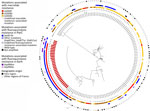Disclaimer: Early release articles are not considered as final versions. Any changes will be reflected in the online version in the month the article is officially released.
Author affiliation: University of Bordeaux–National Centre for Scientific Research, Bordeaux, France (S. Pereyre, N. Henin, C. Bébéar); Bordeaux University Hospital, Bordeaux (S. Pereyre, C. Laurier-Nadalié, C. Balcon, A. Dolzy, M. Gardette, J. Guiraud, C. Bébéar)
Macrolide resistance in Mycoplasma genitalium is rapidly increasing worldwide (1). Reports have noted the spread of macrolide resistance in this species to be polyclonal (2–4), but a few resistant clones may be circulating, particularly in men (3). To search for the potential spread of M. genitalium macrolide-resistant clones in men in France, we performed a prospective nationwide survey to investigate the mgpB type of macrolide-resistant strains.
During September 15–October 15 in 2021 and 2022, we carried out a systematic collection of M. genitalium–positive specimens from men from diagnostic laboratories in France and detected resistance-associated mutations using 23S rRNA and parC gene Sanger sequencing (5). In cases of Sanger sequencing failure, our investigator group used the commercial kits ResistancePlus MG assay (SpeeDx, https://plexpcr.com/home-us) and MGMO qPCR (NYtor, https://www.nytor.nl; which detects 4 parC mutations associated with fluoroquinolone resistance) to increase the sensitivity of mutation detection, but those kits did not specify the mutation location. In a related investigation, members of our research team searched mutations in the quinolone resistance–determining region of DNA gyrase by Sanger sequencing among ParC-mutated strains (3). We performed typing on all macrolide-resistant strains using single nucleotide polymorphism analysis of the mgpB adhesin gene (3).
In this study, we collected M. genitalium–positive specimens from 229 male patients from 38 laboratories in France in 2021 and from 191 male patients from 37 laboratories in 2022. The overall prevalence of macrolide-resistant mutations was 53.2% (95% CI 47.9%–58.3%), and the percentage of fluoroquinolone resistant mutations was 25.2% (95% CI 20.8%–30.1%).
The most frequent macrolide resistance–associated mutation was A2059G (46.6%, Escherichia coli numbering), followed by the A2058T substitution (33.5%) and the A2058G mutation (19.5%). The proportion of A2058T transversion increased significantly in 2022 compared with data from 2018 (18.8% in 2018 vs. 33.5% in 2021–2022, p = 0.01) (5). Strains with the A2058T substitution harbored significantly more fluoroquinolone resistance–associated Ser83Ile substitutions in ParC (66.0%, M. genitalium numbering) than those harboring other macrolide resistance–associated mutations (14.6%; p<0.001) and the 23S rRNA wild-type strains (4.3%; p<0.001) (Table). The A20258T substitution was more frequently detected in men who have sex with men (MSM) (86.7%) and in the Paris area (49.1%) (Table).
mgpB typing of macrolide-resistant specimens revealed 47 distinct sequence types (STs), including 16 new types numbered ST339, ST347, ST350–ST356, and ST359–ST365 (Figure 1). ST159 was the most frequent ST, representing 20.2% (33 of 163 specimens with successful mgpB typing among the 185 macrolide-resistant specimens). All ST159 strains for which the nature of the mutation could be determined harbored both the A2058T transversion in 23S rRNA and the Ser83Ile substitution in ParC (Figure). Moreover, 94.1% of ST159 were from MSM or bisexual persons, and 63.6% (21/33) were from the Paris region. All 5 strains harboring a substitution at position Asp99 (M. genitalium numbering) in GyrA—which is a position where mutations increase the likelihood of moxifloxacin failure (6)—were ST159, of which 4 harbored an A2058T transversion in 23S rRNA and 1 had an undefined 23S rRNA mutation (Table, Figure).
Two studies have reported an increased prevalence of the A2058T mutation, one in the Netherlands and the other in Belgium, but those studies did not perform typing (7,8). In Spain, the emergence of the A20258T substitution has contributed to increasing macrolide resistance (9). A clonal spread was not retained by the authors despite a lower genetic diversity than expected. During 2018–2019, 8 MSM who lived in Paris were infected by a macrolide-resistant ST159 strain harboring a Ser83Ile ParC mutation, but the nature of the 23S rRNA mutation was not determined (3). Considering those data, we typed all the M. genitalium strains harboring the A2058T substitution detected in our previous 2018–2020 study (5). In total, 82.4% (28/34) A2058T strains belonged to ST159, suggesting that the A2058T-ST159 clone may have been spreading undetected for several years.
The limitations of this study were that 41.7% of the HIV and 55.2% of the sexual behavior data were missing, and only specimens harboring macrolide-resistant isolates were mgpB-typed. However, we previously showed that ST159 was much more prevalent among macrolide-resistant strains (10.6%) than among susceptible strains (0.2%) and was particularly prevalent in MSM (3). Thus, we strongly suspect the diffusion of a dual-resistant M. genitalium clone. Our research suggests that macrolide resistance detection kits would benefit from displaying the A2058T mutation in 23S rRNA, which is predictive of the fluoroquinolone resistance–associated mutation and thus of the possible failure of the first- and second-line treatments for M. genitalium infections. Considering the few therapeutic options in cases of macrolide and moxifloxacin resistance (10), the spread of such a dual-resistant clone is of concern.
In conclusion, we report an increase in the proportion of the A2058T mutation among macrolide-resistant M. genitalium strains in France during 2021–2022. We also note the spread of a dual-resistant 23S rRNA A2058T-ParC Ser83Ile M. genitalium ST159 clone, most likely circulating in MSM from the Paris, France, area.
Dr. Pereyre is a clinical microbiologist at Bordeaux University Hospital and the French National Reference Center for Sexually Transmitted Bacterial Infections. Her research interests include antibiotic resistance and typing and detection methods of human mycoplasmas.
Members of the investigator group (city): Alauzet Corentine (Nancy), Amzalag Jonas (Saint-Denis), Auger Gabriel (Rennes), Bador Julien (Dijon), Barnaud Guilène (Colombes), Barrial-Lochet Kildie (Valence), Beby-Defaux Agnès (Poitiers), Bianchi Anne (Bondy), Bonzon Lucas (Montpellier), Bourgeois-Nicolaos Nadège (Clamart), Breit Laure (Colmar), Caméléna François (Paris), Chorda Camille (Aix-en-Provence), Coudène Passcal (Rodez), Daure Sophie (Montluçon), Duchamp-Dominé Marie (Toulon), Duployez Claire (Lille), Ebel Anne (Ivry-Sur-Seine), Edouard Sophie (Marseille), Ennouchi Franck (Montreuil-Juigné), Floch Pauline (Toulouse), Gibaud-Papin Sophie-Anne (Nantes), Gonzalo Sylvie (Saint-Etienne), Grob Anne (Marseille), Guillaume Clémence (Orléans), Huck Sébastien (Strasbourg), Jabnoune Inès (Saint-Denis), Koebel Christelle (Strasbourg), Lanotte Philippe (Tours), Le Bars Hervé (Brest), Malandain Damasie (Caen), Marque Juillet Stéphanie (Versailles), Mendes Lucile (Cahors), Patoz Pierre (Tourcoing), Pierrat Gautier (Paris), Potiron Grégoire (La Roche-sur-Yon), Potron Anaïs (Besançon), Rault Jean-Philippe (Metz), Rondinaud Emilie (Paris), Roumanet Frédérique (Décines), Roux Anne-Laure (Boulogne), Saïd-Delattre Ophélie (Levallois-Perret), Salord Hélène (Lyon), Trombert Sabine (Saint-Ouen-l’Aumône), Valade Hélène (Bordeaux), Zouak Fatma (Dijon).
Access to the newly described mgpB types ST339, ST347, ST350–ST356, and ST359–ST365 can be found in Genbank under accession nos. PP737211, ON933574, PP737220–PP737226, and PP737229–PP737235.
Remnants of specimens were preserved at the Centre de Resource Biologique-Bordeaux Biothèque Santé (CRB-BBS) of Bordeaux University Hospital under collection number BB-0033–00094 and authorization AC-2014–2166 from the French Ministry of Higher Education and Research with no information regarding patient identity. All patient data were anonymously reported.
This study received financial support from the French National Public Health Agency (Saint-Maurice, France) via the French National Reference Center for sexually transmitted bacterial infections.







